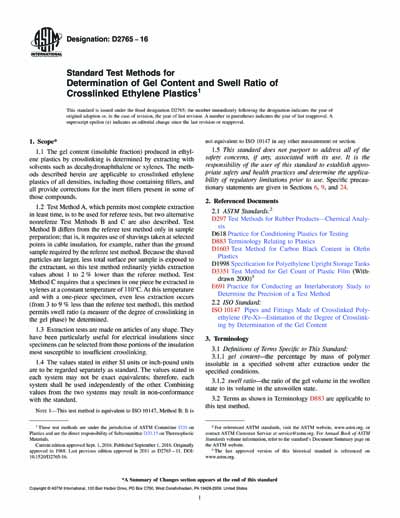Historical
ASTM D2765-16
Standard Test Methods for Determination of Gel Content and Swell Ratio of Crosslinked Ethylene Plastics
1.1 The gel content (insoluble fraction) produced in ethylene plastics by crosslinking is determined by extracting with solvents such as decahydronaphthalene or xylenes. The methods described herein are applicable to crosslinked ethylene plastics of all densities, including those containing fillers, and all provide corrections for the inert fillers present in some of those compounds.
1.2 Test Method A, which permits most complete extraction in least time, is to be used for referee tests, but two alternative nonreferee Test Methods B and C are also described. Test Method B differs from the referee test method only in sample preparation; that is, it requires use of shavings taken at selected points in cable insulation, for example, rather than the ground sample required by the referee test method. Because the shaved particles are larger, less total surface per sample is exposed to the extractant, so this test method ordinarily yields extraction values about 1 to 2 % lower than the referee method. Test Method C requires that a specimen in one piece be extracted in xylenes at a constant temperature of 110°C. At this temperature and with a one-piece specimen, even less extraction occurs (from 3 to 9 % less than the referee test method), this method permits swell ratio (a measure of the degree of crosslinking in the gel phase) be determined.
1.3 Extraction tests are made on articles of any shape. They have been particularly useful for electrical insulations since specimens can be selected from those portions of the insulation most susceptible to insufficient crosslinking.
1.4 The values stated in either SI units or inch-pound units are to be regarded separately as standard. The values stated in each system may not be exact equivalents; therefore, each system shall be used independently of the other. Combining values from the two systems may result in non-conformance with the standard.
1.5 This standard does not purport to address all of the safety concerns, if any, associated with its use. It is the responsibility of the user of this standard to establish appropriate safety and health practices and determine the applicability of regulatory limitations prior to use. Specific precautionary statements are given in Sections 6, 9, and 24.
Content Provider
ASTM International [astm]






